The AMD Ryzen 9 3950X Review: 16 Cores on 7nm with PCIe 4.0
by Dr. Ian Cutress on November 14, 2019 9:00 AM ESTCPU Performance: Rendering Tests
Rendering is often a key target for processor workloads, lending itself to a professional environment. It comes in different formats as well, from 3D rendering through rasterization, such as games, or by ray tracing, and invokes the ability of the software to manage meshes, textures, collisions, aliasing, physics (in animations), and discarding unnecessary work. Most renderers offer CPU code paths, while a few use GPUs and select environments use FPGAs or dedicated ASICs. For big studios however, CPUs are still the hardware of choice.
All of our benchmark results can also be found in our benchmark engine, Bench.
Corona 1.3: Performance Render
An advanced performance based renderer for software such as 3ds Max and Cinema 4D, the Corona benchmark renders a generated scene as a standard under its 1.3 software version. Normally the GUI implementation of the benchmark shows the scene being built, and allows the user to upload the result as a ‘time to complete’.
We got in contact with the developer who gave us a command line version of the benchmark that does a direct output of results. Rather than reporting time, we report the average number of rays per second across six runs, as the performance scaling of a result per unit time is typically visually easier to understand.
The Corona benchmark website can be found at https://corona-renderer.com/benchmark
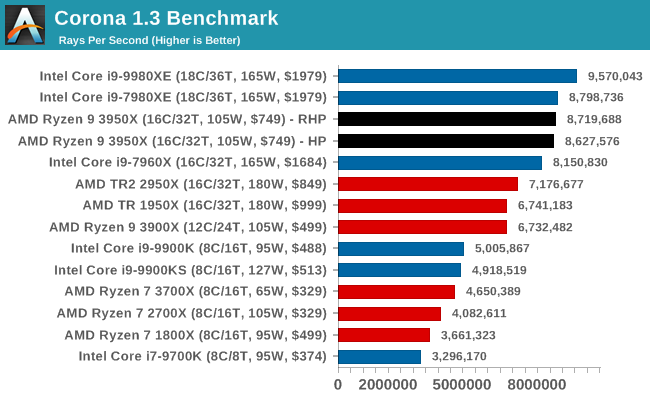
Intel's HEDT chips are quite good at Corona, but if we compare the 3900X to the 3950X, we still see some good scaling.
Blender 2.79b: 3D Creation Suite
A high profile rendering tool, Blender is open-source allowing for massive amounts of configurability, and is used by a number of high-profile animation studios worldwide. The organization recently released a Blender benchmark package, a couple of weeks after we had narrowed our Blender test for our new suite, however their test can take over an hour. For our results, we run one of the sub-tests in that suite through the command line - a standard ‘bmw27’ scene in CPU only mode, and measure the time to complete the render.
Blender can be downloaded at https://www.blender.org/download/
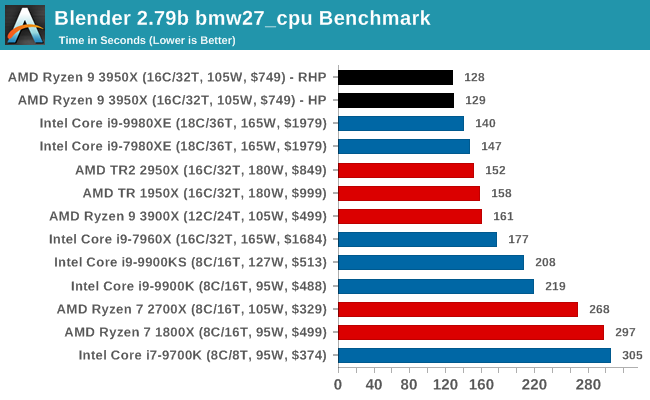
AMD is taking the lead in our blender test, with the 16-core chips easily going through Intel's latest 18-core hardware.
LuxMark v3.1: LuxRender via Different Code Paths
As stated at the top, there are many different ways to process rendering data: CPU, GPU, Accelerator, and others. On top of that, there are many frameworks and APIs in which to program, depending on how the software will be used. LuxMark, a benchmark developed using the LuxRender engine, offers several different scenes and APIs.
In our test, we run the simple ‘Ball’ scene on both the C++ code path, in CPU mode. This scene starts with a rough render and slowly improves the quality over two minutes, giving a final result in what is essentially an average ‘kilorays per second’.
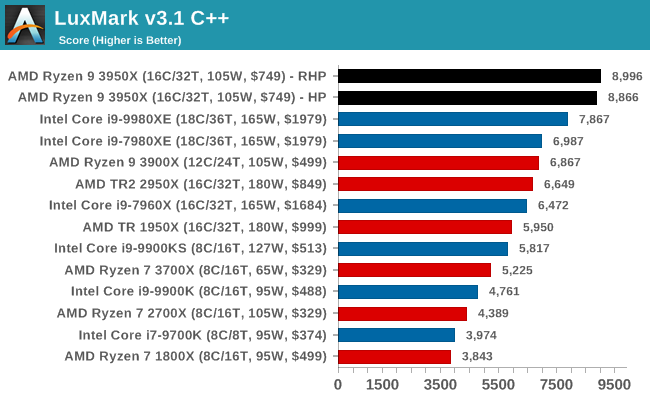
Despite using Intel's Embree engine, again AMD's 16-cores easily win out against Intel's 18-core chips, at under half the cost.
POV-Ray 3.7.1: Ray Tracing
The Persistence of Vision ray tracing engine is another well-known benchmarking tool, which was in a state of relative hibernation until AMD released its Zen processors, to which suddenly both Intel and AMD were submitting code to the main branch of the open source project. For our test, we use the built-in benchmark for all-cores, called from the command line.
POV-Ray can be downloaded from http://www.povray.org/
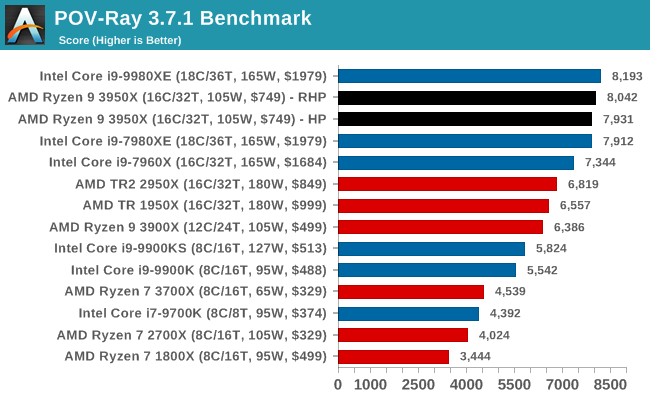
POV-Ray ends up with AMD 16-core splitting the two Intel 18-core parts, which means we're likely to see the Intel Core i9-10980XE at the top here. It would have been interesting to see where an Intel 16-core Core-X on Cascade would end up for a direct comparison, but Intel has no new 16-core chip planned.


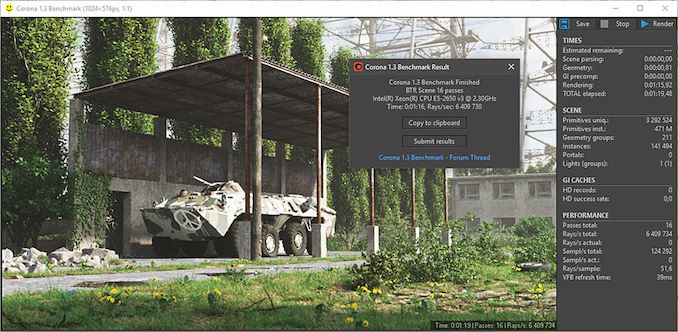








206 Comments
View All Comments
rret - Thursday, November 14, 2019 - link
we have nearly 400 million dollars - you give us gold award and then we release the money to you. my lawyer will call you...either that or my attorney general. stay close to phone!Kishoreshack - Friday, November 15, 2019 - link
That's a good thingI hope we scrap out gold awards in all together
Only recommended is what matters
soo we know all Anandtech recommendations carry same weight
Hope to see you implement this
Oliseo - Thursday, November 14, 2019 - link
No brown envelope at the usual deadrop.Irata - Thursday, November 14, 2019 - link
Just curious: Were the Intel systems fully patched, including the new JCC Microcode update ?ydeer - Thursday, November 14, 2019 - link
Excellent question.Ian Cutress - Thursday, November 14, 2019 - link
Did I run 30hr+ of tests on each of those Intel processors with a patch from an announcement 24 hours prior? No, of course not.Irata - Thursday, November 14, 2019 - link
I did not expect this to be honest. Must not be fun testing with the different security related updates from Intel or Bios patches from AMD that come out regularly.Might be worth adding a mention to the review since the JCC and Zombieload 2 updates can have a performance impact (as per Phoronix).
Irata - Thursday, November 14, 2019 - link
Oh, and not to be rude - thank you very much for this through review Ian.Flying Aardvark - Friday, November 15, 2019 - link
Can you at notate that in the review in large bold print, and that it's likely to affect performance, possibly dramatically for the Intel CPUs?lukx - Thursday, November 14, 2019 - link
what where the temperatures? can you use air cooling?